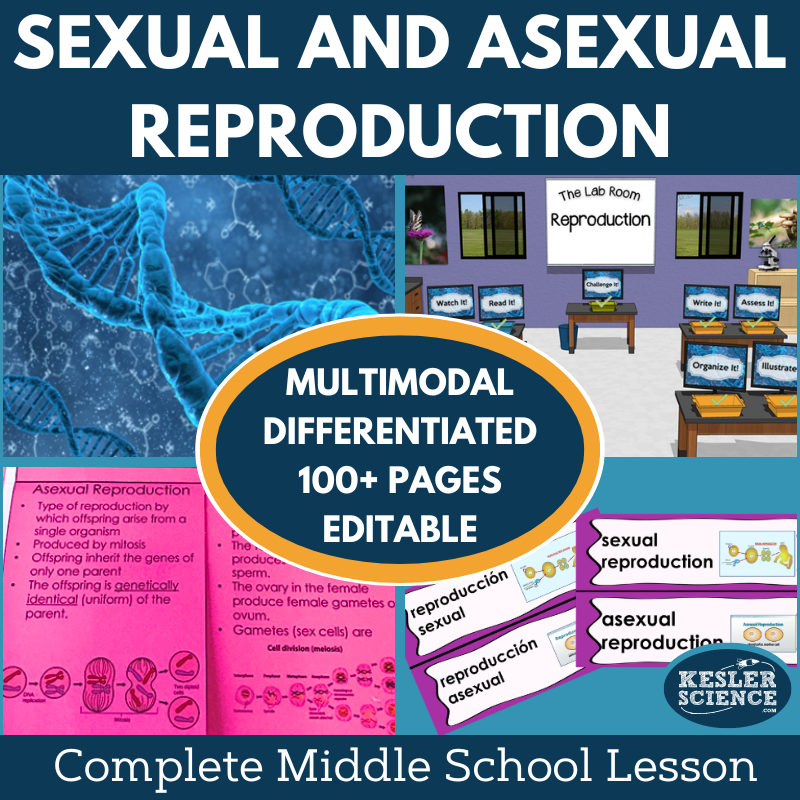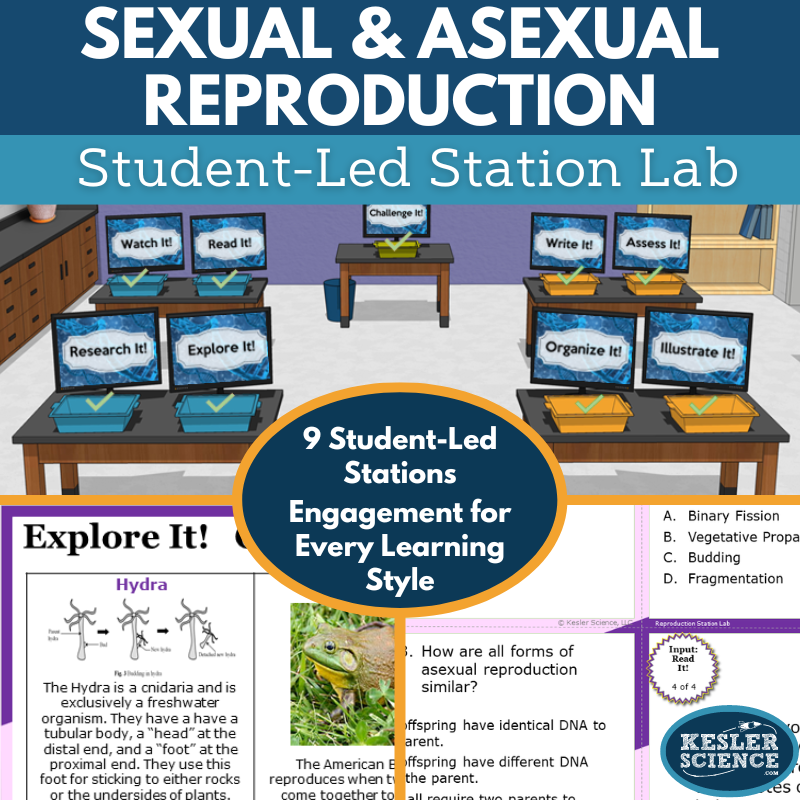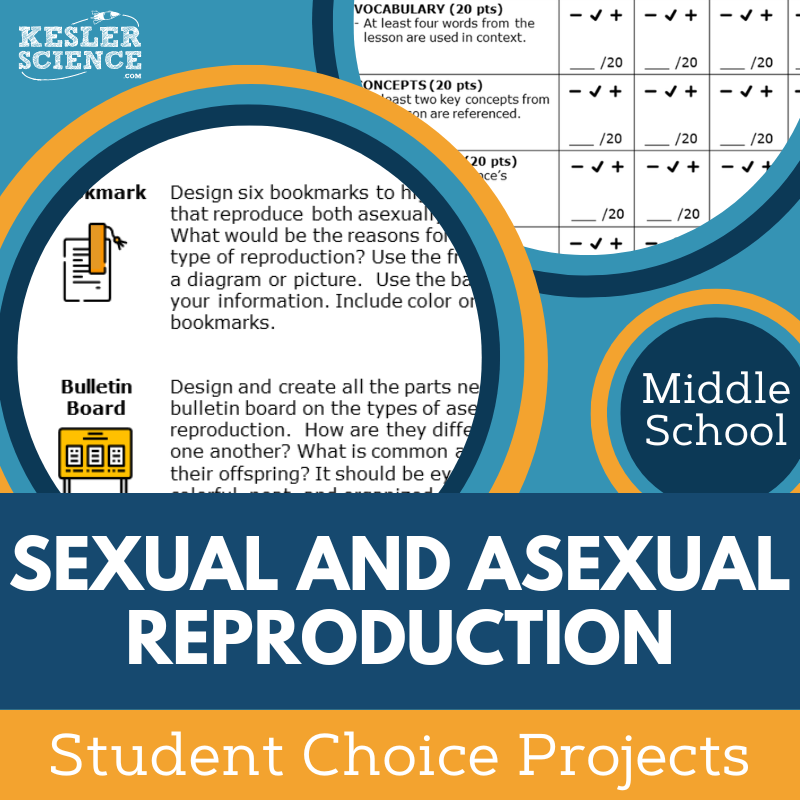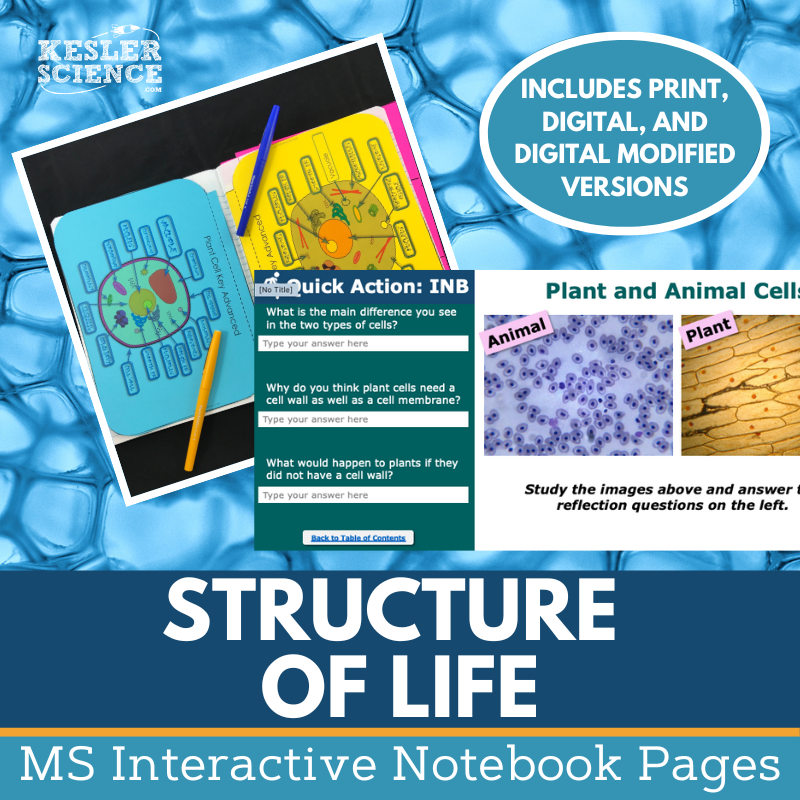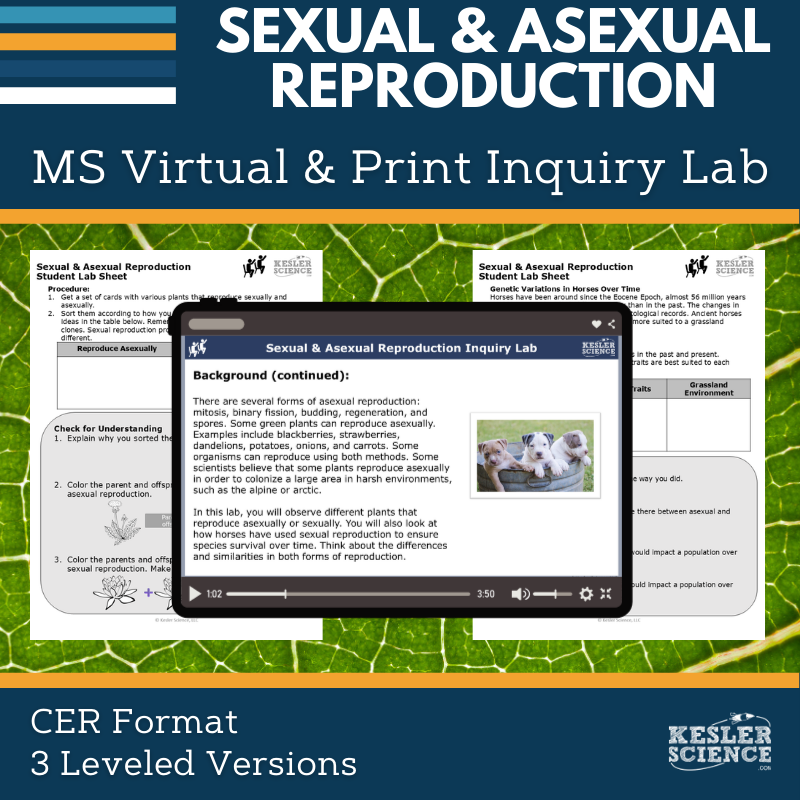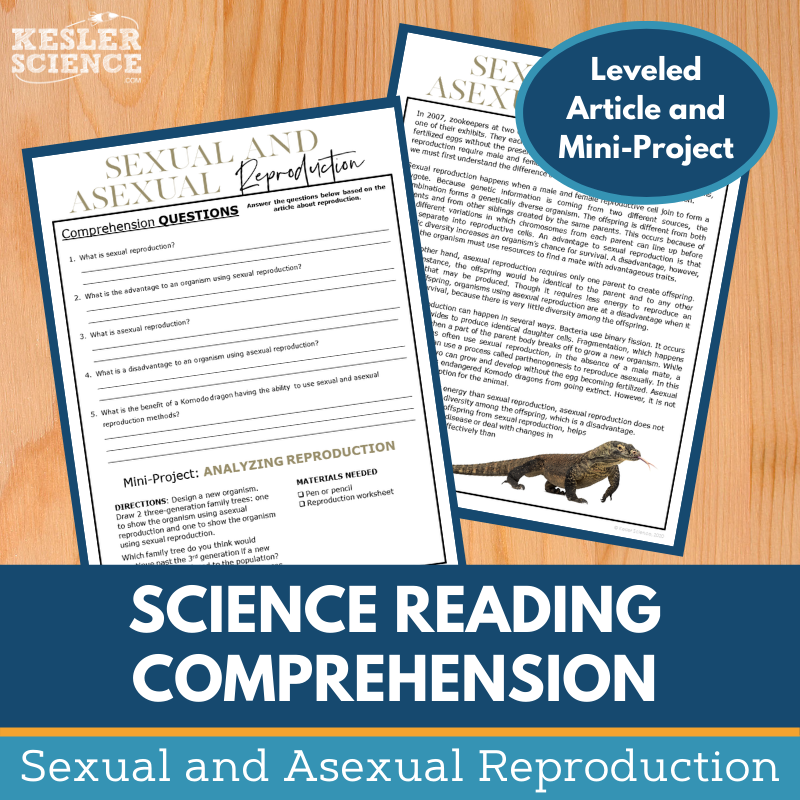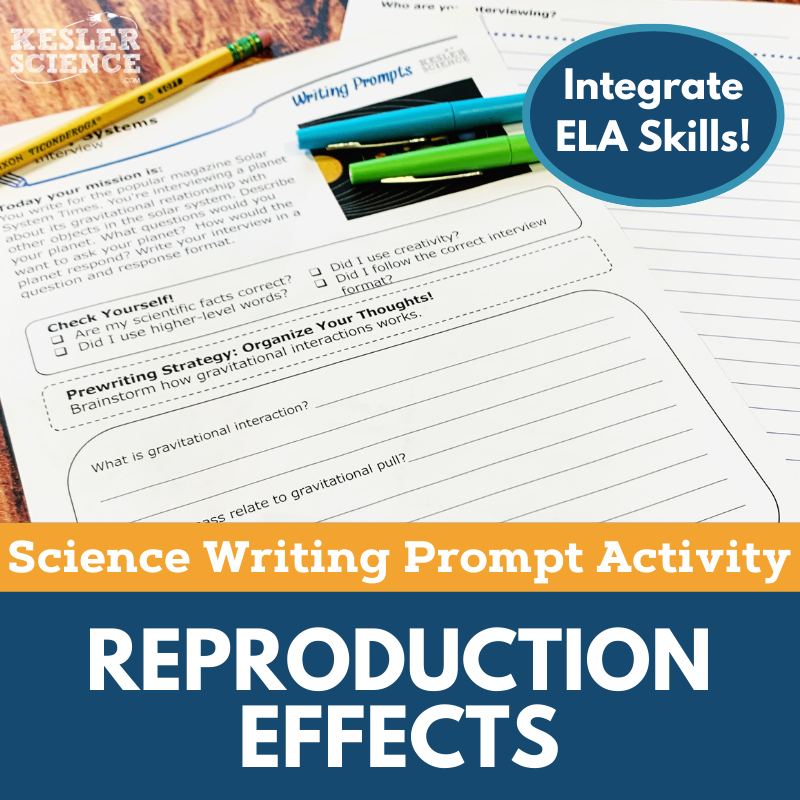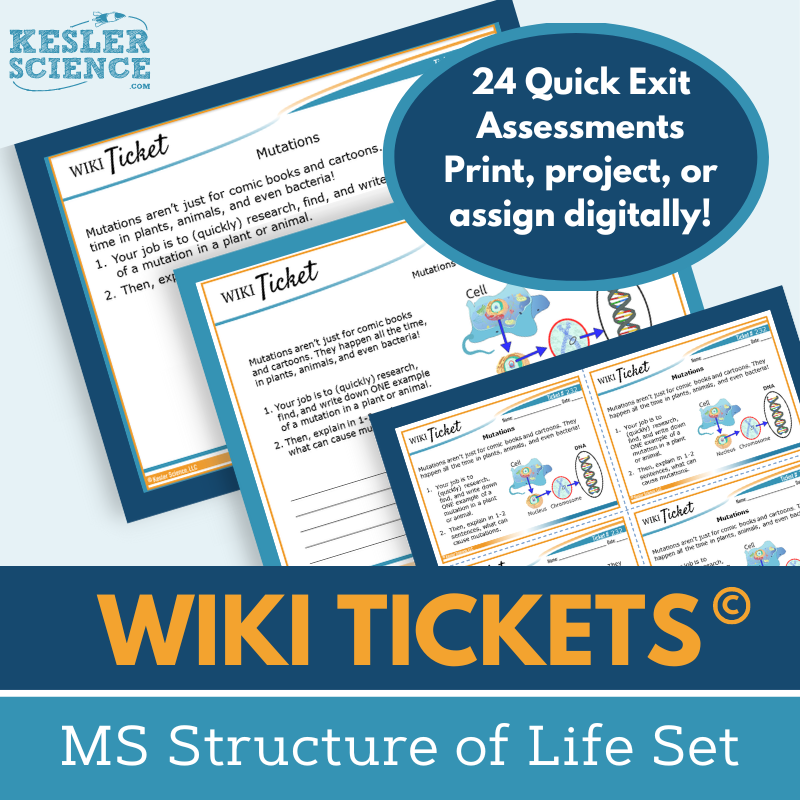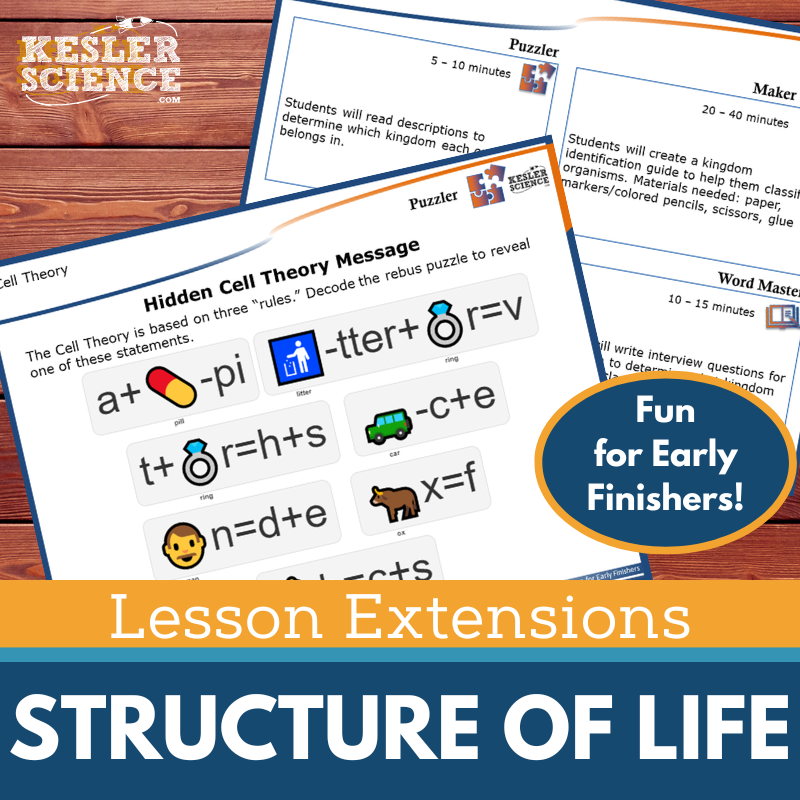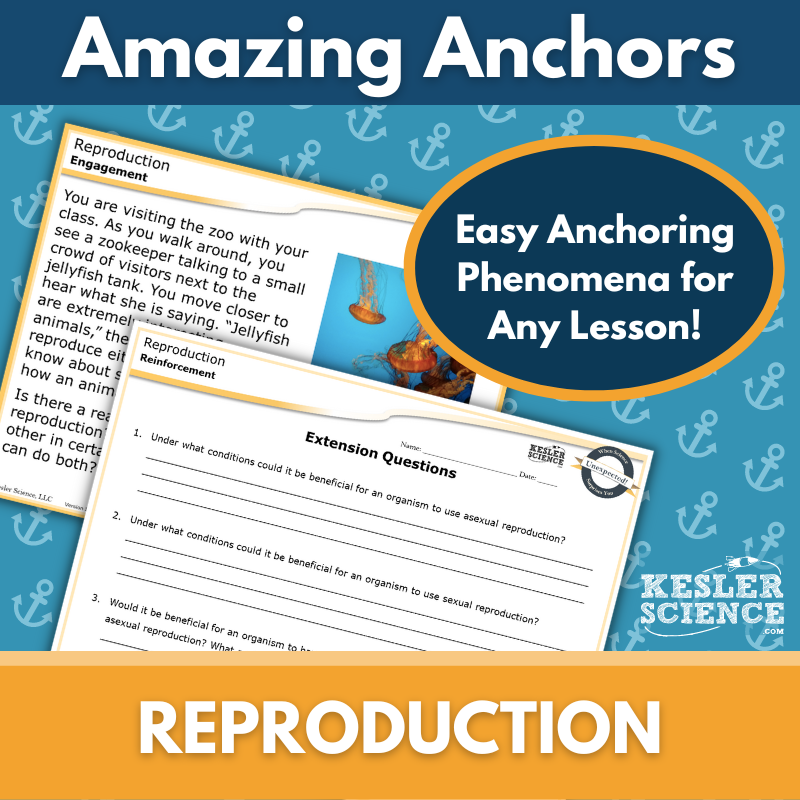Sexual and Asexual Reproduction Activities for Middle School Science
The Kesler Science Sexual and Asexual Reproduction resources offer a comprehensive, engaging, and student-centered approach to teaching middle school students about the processes of sexual and asexual reproduction. The resources below will give students a comprehensive understanding of sexual and asexual reproduction. All of the following materials are also included in the Kesler Science Membership.
The Kesler Science Sexual and Asexual Reproduction Complete 5E Lesson provides everything you need to teach a multi-day, engaging lesson with minimal prep. This student-centered, differentiated lesson allows your 6th–8th grade students to explore essential questions about reproduction, genetics, and offspring diversity. With both printable and digital materials, the lesson is easily adaptable to fit your classroom needs, including Spanish translations and editable PowerPoints for maximum flexibility.
The lesson is structured using the 5E Model—Engagement, Exploration, Explanation, Elaboration, and Evaluation—ensuring a comprehensive approach to learning. Students engage with the content through nine differentiated station labs that provide multimodal activities, such as reading, videos, research, hands-on demonstrations, and writing. The output stations allow students to demonstrate their understanding through organizing, illustrating, and responding to questions, while a bonus "Challenge It!" station offers extra enrichment for advanced learners.
This resource is ideal for both in-person and virtual classrooms, with everything from interactive notebook templates to editable assessment materials included. Whether used for classroom instruction, homework, or virtual learning environments, this complete lesson offers a rich, flexible learning experience for all students.
The Kesler Science Sexual and Asexual Reproduction Complete 5E Lesson provides everything you need to teach a multi-day, engaging lesson with minimal prep. This student-centered, differentiated lesson allows your 6th–8th grade students to explore essential questions about reproduction, genetics, and offspring diversity. With both printable and digital materials, the lesson is easily adaptable to fit your classroom needs, including Spanish translations and editable PowerPoints for maximum flexibility.
The lesson is structured using the 5E Model—Engagement, Exploration, Explanation, Elaboration, and Evaluation—ensuring a comprehensive approach to learning. Students engage with the content through nine differentiated station labs that provide multimodal activities, such as reading, videos, research, hands-on demonstrations, and writing. The output stations allow students to demonstrate their understanding through organizing, illustrating, and responding to questions, while a bonus "Challenge It!" station offers extra enrichment for advanced learners.
This resource is ideal for both in-person and virtual classrooms, with everything from interactive notebook templates to editable assessment materials included. Whether used for classroom instruction, homework, or virtual learning environments, this complete lesson offers a rich, flexible learning experience for all students.
The Kesler Science Sexual and Asexual Reproduction Station Lab is a modular, student-led activity designed to engage middle school students in learning about sexual and asexual reproduction. This lesson allows students to explore the concepts independently or in small groups through nine differentiated stations, each providing a unique opportunity to absorb and apply new information. With a teacher-facilitated approach, this activity saves preparation time while promoting student-driven learning.
The stations cover both input and output activities. Input stations include hands-on demonstrations, research tasks, reading comprehension, and videos, all designed to introduce students to the key differences between sexual and asexual reproduction. Output stations allow students to demonstrate their learning through organizing information, illustrating models, writing responses, and assessing their understanding with task cards. The bonus "Challenge It!" station provides enrichment for early finishers, offering crosswords, games, and mini-projects.
This resource is perfect for both in-person and virtual learning environments, making it versatile and accessible. It includes all necessary materials, signage, and task cards, ensuring a seamless and engaging learning experience. Whether used for differentiated learning or as part of the comprehensive Sexual and Asexual Reproduction 5E Lesson Plan, this station lab keeps students engaged while deepening their understanding of reproduction.
The Kesler Science Sexual and Asexual Reproduction Station Lab is a modular, student-led activity designed to engage middle school students in learning about sexual and asexual reproduction. This lesson allows students to explore the concepts independently or in small groups through nine differentiated stations, each providing a unique opportunity to absorb and apply new information. With a teacher-facilitated approach, this activity saves preparation time while promoting student-driven learning.
The stations cover both input and output activities. Input stations include hands-on demonstrations, research tasks, reading comprehension, and videos, all designed to introduce students to the key differences between sexual and asexual reproduction. Output stations allow students to demonstrate their learning through organizing information, illustrating models, writing responses, and assessing their understanding with task cards. The bonus "Challenge It!" station provides enrichment for early finishers, offering crosswords, games, and mini-projects.
This resource is perfect for both in-person and virtual learning environments, making it versatile and accessible. It includes all necessary materials, signage, and task cards, ensuring a seamless and engaging learning experience. Whether used for differentiated learning or as part of the comprehensive Sexual and Asexual Reproduction 5E Lesson Plan, this station lab keeps students engaged while deepening their understanding of reproduction.
The Kesler Science Sexual and Asexual Reproduction Student Choice Projects encourage middle school students to showcase their learning through personalized, creative methods. With six engaging project options and a "design your own" choice, students can select the format that best suits their interests and learning style. A flexible grading rubric allows for assessments by teachers, peers, or students themselves, ensuring a comprehensive evaluation of vocabulary, concepts, clarity, and presentation.
This resource is designed with differentiation in mind, offering two versions of the project page. The modified version includes three options tailored for students needing additional support, while advanced learners can be challenged with multiple projects. The projects use everyday classroom materials like paper, markers, and scissors, with options for digital completion, making it versatile and easy to implement.
Perfect for fostering creativity and deep understanding, these projects are suitable for diverse learners and learning environments. Whether used in-class or digitally, this resource encourages student ownership, supports varied needs, and creates an engaging experience for exploring sexual and asexual reproduction.
The Kesler Science Sexual and Asexual Reproduction Student Choice Projects encourage middle school students to showcase their learning through personalized, creative methods. With six engaging project options and a "design your own" choice, students can select the format that best suits their interests and learning style. A flexible grading rubric allows for assessments by teachers, peers, or students themselves, ensuring a comprehensive evaluation of vocabulary, concepts, clarity, and presentation.
This resource is designed with differentiation in mind, offering two versions of the project page. The modified version includes three options tailored for students needing additional support, while advanced learners can be challenged with multiple projects. The projects use everyday classroom materials like paper, markers, and scissors, with options for digital completion, making it versatile and easy to implement.
Perfect for fostering creativity and deep understanding, these projects are suitable for diverse learners and learning environments. Whether used in-class or digitally, this resource encourages student ownership, supports varied needs, and creates an engaging experience for exploring sexual and asexual reproduction.
The Kesler Science Structure of Life Interactive Notebook Bundle provides an engaging way for students to explore life science concepts through interactive activities. Designed for both print and digital use, this resource is perfect for traditional classrooms, 1:1 environments, and distance learning. Topics covered include cell theory, genetics, plant and animal cells, and more, offering a comprehensive tool for teaching the structure of life.
The digital version includes a unique interactive notebook PowerPoint that can be uploaded to platforms like Google Slides or MS Teams, complete with reflection pages, note spaces, and an answer key. A modified digital version is also provided for students needing accommodations. The paper version features blank and pre-filled templates, along with color photos to guide usage, ensuring all students can participate effectively.
With resources tailored for diverse learning needs, the Kesler Science Structure of Life Interactive Notebook Bundle supports differentiated instruction and student-centered learning. Teachers gain a versatile tool for enhancing understanding, while students build lasting connections to key life science concepts.
The Kesler Science Structure of Life Interactive Notebook Bundle provides an engaging way for students to explore life science concepts through interactive activities. Designed for both print and digital use, this resource is perfect for traditional classrooms, 1:1 environments, and distance learning. Topics covered include cell theory, genetics, plant and animal cells, and more, offering a comprehensive tool for teaching the structure of life.
The digital version includes a unique interactive notebook PowerPoint that can be uploaded to platforms like Google Slides or MS Teams, complete with reflection pages, note spaces, and an answer key. A modified digital version is also provided for students needing accommodations. The paper version features blank and pre-filled templates, along with color photos to guide usage, ensuring all students can participate effectively.
With resources tailored for diverse learning needs, the Kesler Science Structure of Life Interactive Notebook Bundle supports differentiated instruction and student-centered learning. Teachers gain a versatile tool for enhancing understanding, while students build lasting connections to key life science concepts.
The Kesler Science Sexual and Asexual Reproduction Inquiry Lab aligns with NGSS standards by helping students explore the differences between asexual and sexual reproduction in plants. Students will sort reproduction method cards and examine how horses have evolved over time through inherited traits. Throughout the lab, they will analyze the advantages and disadvantages of uniform versus diverse offspring.
This flexible lab includes both hands-on and digital formats, each with comprehension questions, Claim-Evidence-Reasoning (C.E.R.) prompts, and a reflection section. Differentiation is built in with three versions—Modified, Dependent, and Independent—so teachers can easily meet the needs of diverse learners. In-person materials include plant cards, hydrogen peroxide, glass slides, cover slips, and pipettes, while the digital version requires no supplies.
The resource is fully editable and compatible with Google Slides, allowing for customization and integration into various learning platforms. It includes teacher support materials, answer keys, and student versions at all three difficulty levels. Whether printed or virtual, this lab engages students with meaningful science exploration and critical thinking.
The Kesler Science Sexual and Asexual Reproduction Inquiry Lab aligns with NGSS standards by helping students explore the differences between asexual and sexual reproduction in plants. Students will sort reproduction method cards and examine how horses have evolved over time through inherited traits. Throughout the lab, they will analyze the advantages and disadvantages of uniform versus diverse offspring.
This flexible lab includes both hands-on and digital formats, each with comprehension questions, Claim-Evidence-Reasoning (C.E.R.) prompts, and a reflection section. Differentiation is built in with three versions—Modified, Dependent, and Independent—so teachers can easily meet the needs of diverse learners. In-person materials include plant cards, hydrogen peroxide, glass slides, cover slips, and pipettes, while the digital version requires no supplies.
The resource is fully editable and compatible with Google Slides, allowing for customization and integration into various learning platforms. It includes teacher support materials, answer keys, and student versions at all three difficulty levels. Whether printed or virtual, this lab engages students with meaningful science exploration and critical thinking.
The Kesler Science Sexual and Asexual Reproduction Reading Comprehension Activity engages middle school students with a nonfiction article about the outcomes of uniform or diverse offspring from sexual and asexual reproduction. Students answer comprehension questions and complete a creative mini-project where they design a new organism and analyze generational reproduction outcomes. This lesson boosts science literacy while fostering creativity and critical thinking.
The activity includes leveled passages for grades 6–8 (and advanced 5th graders) with Lexile levels of 1100–1300, colorful graphics, and Cornell notes templates. Students can work hands-on with a mini-project, answer 5–7 comprehension questions, and engage in meaningful class discussions. Materials are designed for both in-person and virtual learning, with digital files compatible with Google Classroom, Schoology, and other platforms.
Perfect for whole-class instruction, extra credit, sub plans, or ISS, this resource offers flexibility and enrichment. Teachers can assign it as part of a unit or a stand-alone activity, tailoring the lesson to student needs. The activity encourages textual analysis and strengthens reading comprehension while making science concepts accessible and engaging.
The Kesler Science Sexual and Asexual Reproduction Reading Comprehension Activity engages middle school students with a nonfiction article about the outcomes of uniform or diverse offspring from sexual and asexual reproduction. Students answer comprehension questions and complete a creative mini-project where they design a new organism and analyze generational reproduction outcomes. This lesson boosts science literacy while fostering creativity and critical thinking.
The activity includes leveled passages for grades 6–8 (and advanced 5th graders) with Lexile levels of 1100–1300, colorful graphics, and Cornell notes templates. Students can work hands-on with a mini-project, answer 5–7 comprehension questions, and engage in meaningful class discussions. Materials are designed for both in-person and virtual learning, with digital files compatible with Google Classroom, Schoology, and other platforms.
Perfect for whole-class instruction, extra credit, sub plans, or ISS, this resource offers flexibility and enrichment. Teachers can assign it as part of a unit or a stand-alone activity, tailoring the lesson to student needs. The activity encourages textual analysis and strengthens reading comprehension while making science concepts accessible and engaging.
The Reproduction Effects science writing activity engages middle school students in a compare-and-contrast essay to demonstrate their understanding of life science concepts. Designed to support both print and digital learning environments, this low-prep activity encourages students to expand their science reasoning through writing. Whether used in-person or virtually, the prompt format supports independent exploration and reinforces key ideas about reproduction in a creative and meaningful way.
This TEKS- and NGSS-aligned writing prompt includes everything teachers need to implement the activity smoothly: clear directions, an answer guide, rubrics, pre-writing strategies, and printable handouts in both full and half-sheet formats. A digital interactive version is also included, making it easy to assign through PowerPoint or Google Slides. Materials are editable to fit individual classroom needs and integrate well into interactive notebooks or writing journals.
The Reproduction Effects prompt is a flexible classroom tool that can be used for cross-curricular activities, pre-test assessments, student choice projects, early finisher enrichment, or make-up work. It also serves well as a TELPAS writing sample or differentiated assignment. Students’ work can be displayed or collected in personal writing anthologies, enhancing both engagement and science literacy.
The Reproduction Effects science writing activity engages middle school students in a compare-and-contrast essay to demonstrate their understanding of life science concepts. Designed to support both print and digital learning environments, this low-prep activity encourages students to expand their science reasoning through writing. Whether used in-person or virtually, the prompt format supports independent exploration and reinforces key ideas about reproduction in a creative and meaningful way.
This TEKS- and NGSS-aligned writing prompt includes everything teachers need to implement the activity smoothly: clear directions, an answer guide, rubrics, pre-writing strategies, and printable handouts in both full and half-sheet formats. A digital interactive version is also included, making it easy to assign through PowerPoint or Google Slides. Materials are editable to fit individual classroom needs and integrate well into interactive notebooks or writing journals.
The Reproduction Effects prompt is a flexible classroom tool that can be used for cross-curricular activities, pre-test assessments, student choice projects, early finisher enrichment, or make-up work. It also serves well as a TELPAS writing sample or differentiated assignment. Students’ work can be displayed or collected in personal writing anthologies, enhancing both engagement and science literacy.
The Kesler Science WIKI Tickets are flexible, engaging formative assessments designed for middle school science topics. The Structure of Life Set includes 24 colorful assessments that can be used as exit tickets, bellringers, or quick checks for understanding. Each topic features five formats: a projection version, three print sizes, and an interactive digital version compatible with PowerPoint or Google Slides.
Aligned with NGSS and TEKS standards, these assessments cover key topics like asexual vs. sexual reproduction, cell functions, heredity, homeostasis, and turgor pressure. The included table of contents helps teachers easily identify alignment with specific standards, ensuring comprehensive coverage. With options for both in-class and virtual learning, these assessments offer maximum flexibility.
These "What I Know Is" assessments provide teachers with a clear picture of student understanding. Whether used in a traditional classroom or a remote setting, they are an easy, engaging way to track progress and identify learning gaps.
The Kesler Science WIKI Tickets are flexible, engaging formative assessments designed for middle school science topics. The Structure of Life Set includes 24 colorful assessments that can be used as exit tickets, bellringers, or quick checks for understanding. Each topic features five formats: a projection version, three print sizes, and an interactive digital version compatible with PowerPoint or Google Slides.
Aligned with NGSS and TEKS standards, these assessments cover key topics like asexual vs. sexual reproduction, cell functions, heredity, homeostasis, and turgor pressure. The included table of contents helps teachers easily identify alignment with specific standards, ensuring comprehensive coverage. With options for both in-class and virtual learning, these assessments offer maximum flexibility.
These "What I Know Is" assessments provide teachers with a clear picture of student understanding. Whether used in a traditional classroom or a remote setting, they are an easy, engaging way to track progress and identify learning gaps.
The Kesler Science Structure of Life Lesson Extensions provide student-choice activities designed to keep fast finishers engaged with critical thinking and creative tasks. These extensions are perfect for wrapping up lessons, filling time during testing, or offering advanced learners opportunities to deepen their understanding of life science concepts. Aligned with NGSS and TEKS standards, the extensions include activities such as puzzles, hands-on Maker Space projects, digital media tasks, and creative writing challenges.
Each Lesson Extension includes teacher directions, answer keys, and both projection and printable versions for maximum flexibility. With topics ranging from cell structure to heredity and natural selection, students can explore concepts through problem-solving, STEAM connections, and creative expression. These activities encourage deeper exploration of topics like artificial selection, genetic mutations, and environmental factors.
Kesler Science Lesson Extensions are ideal for scaffolding learning or challenging independent learners. By incorporating engaging activities like Puzzler, Maker Space, Tech Connection, and Word Master, these resources provide rigorous yet enjoyable options to enrich life science lessons.
The Kesler Science Structure of Life Lesson Extensions provide student-choice activities designed to keep fast finishers engaged with critical thinking and creative tasks. These extensions are perfect for wrapping up lessons, filling time during testing, or offering advanced learners opportunities to deepen their understanding of life science concepts. Aligned with NGSS and TEKS standards, the extensions include activities such as puzzles, hands-on Maker Space projects, digital media tasks, and creative writing challenges.
Each Lesson Extension includes teacher directions, answer keys, and both projection and printable versions for maximum flexibility. With topics ranging from cell structure to heredity and natural selection, students can explore concepts through problem-solving, STEAM connections, and creative expression. These activities encourage deeper exploration of topics like artificial selection, genetic mutations, and environmental factors.
Kesler Science Lesson Extensions are ideal for scaffolding learning or challenging independent learners. By incorporating engaging activities like Puzzler, Maker Space, Tech Connection, and Word Master, these resources provide rigorous yet enjoyable options to enrich life science lessons.
The Amazing Anchors Phenomenon Lesson introduces and reinforces the types of reproduction using a real-world example of jellyfish. Students begin with an engaging introductory reading followed by comprehension and extension questions to spark curiosity. A second reading breaks down the concepts of sexual and asexual reproduction in a clear and accessible way, with additional questions to deepen understanding.
This no-prep, TEKS-aligned resource includes teacher directions with answer keys, editable projection slides, and both print and digital versions. Full- and half-sheet handouts are provided for flexibility in interactive notebooks or classroom displays. Differentiated materials include a modified version with sentence starters and simplified language to support all learners.
Designed to bookend any middle school science lesson, these phenomenon pages work well for the Engagement and Elaborate phases of the 5E model. Whether in-person or virtual, this resource helps students connect reproduction concepts to real-world examples in an interactive and meaningful way.
The Amazing Anchors Phenomenon Lesson introduces and reinforces the types of reproduction using a real-world example of jellyfish. Students begin with an engaging introductory reading followed by comprehension and extension questions to spark curiosity. A second reading breaks down the concepts of sexual and asexual reproduction in a clear and accessible way, with additional questions to deepen understanding.
This no-prep, TEKS-aligned resource includes teacher directions with answer keys, editable projection slides, and both print and digital versions. Full- and half-sheet handouts are provided for flexibility in interactive notebooks or classroom displays. Differentiated materials include a modified version with sentence starters and simplified language to support all learners.
Designed to bookend any middle school science lesson, these phenomenon pages work well for the Engagement and Elaborate phases of the 5E model. Whether in-person or virtual, this resource helps students connect reproduction concepts to real-world examples in an interactive and meaningful way.
Year-Round Resources
These year-round activities will increase your students' understanding of many middle school science topics. All of these activities are also included in the Kesler Science Membership.
Visual Data & Graphing
You're not alone if your students struggle with understanding graphs, charts, and tables. It's a skill that takes an enormous amount of practice. This resource will help students build a strong foundation in analyzing data and creating their own data visualizations.
Bell Ringers and Warm-Ups
These middle school science bell ringers are an excellent way to engage your students as soon as they walk into your classroom. This comprehensive FULL YEAR resource includes everything you need to start off each science class with an interesting warm-up activity.
Review Board Games
Each game board has been carefully designed to keep students engaged. There are 10 different action spaces on each board and dozens of question cards. All of the actions are related to science concepts and keep the students motivated throughout the game.
Each game is ready to play. Simply print out the board and the cards and let the students enjoy reviewing nine different units.
Essential Questions
Below are the essential questions associated with the lessons and activities included in this unit. This topic is only one of more than 100 middle school science topics included in the Kesler Science Membership.
-
How are sexual and asexual reproduction comparable?
-
What types if reproduction produces uniform and diverse offspring?
-
How is genetic information passed from parents to offspring?
Kesler Science Membership
Imagine never having to search for another middle school science lesson again. The membership gives you access to ALL of the Kesler Science products in one place (Yes, including everything above).
Say goodbye to long hours of lesson prep.

